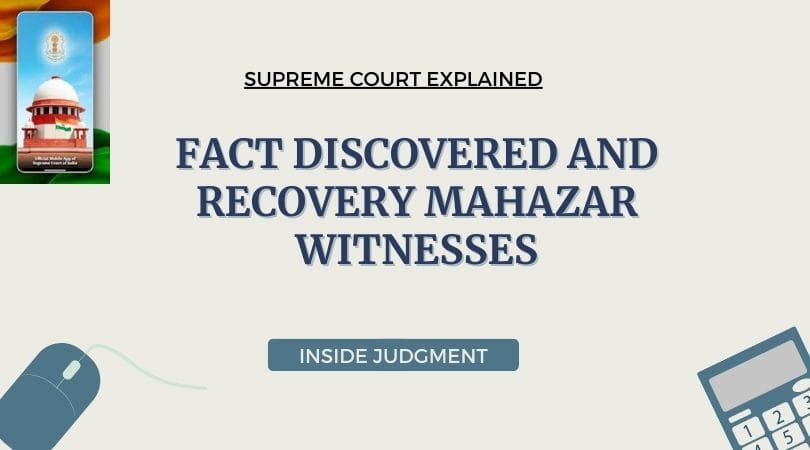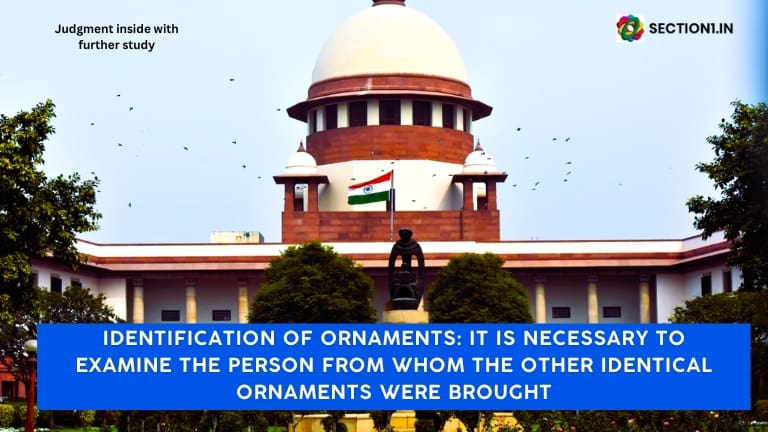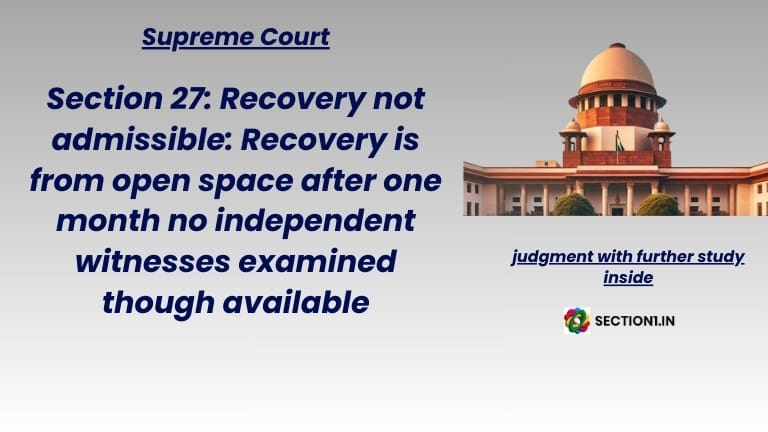Analysis and findings
18. We have considered the submissions advanced by learned counsel for the parties and have also perused the materials on record.
19. There can be no two opinions that the quality of evidence led by the prosecution in the present case to nail Manoj and Kallu was wholly untrustworthy for convicting them and the Trial Court as well as the High Court erred in not acquitting them.
Disclosure statements
20. The facts of the case reveal that all the accused persons made disclosure statements to the I.O. whereupon recovery of money, jewellery, etc. was effected. Although it is quite unusual that all five accused, after being arrested, would lead the I.O. to the places for effecting recovery of the stolen articles, we do not propose to disbelieve the prosecution plea only on this score. Manoj’s involvement was primarily based on the disclosure statements made by co-accused Suleman and Jaihind where they admitted to selling the stolen articles to him and a similar statement made by Manoj himself which led to recovery under Section 27, Evidence Act. Similarly, both the courts below, in convicting Kallu, largely relied upon the disclosure statement made by Kallu himself as well as co-accused Jaihind, who confessed to giving Rs.3,000.00 to Kallu from the stolen money and storing a country-made pistol along with three cartridges at his house/tapra.
Disclosure statements are not per se individual evidence without any corroboration
21. A doubt looms: can disclosure statements per se, unaccompanied by any supporting evidence, be deemed adequate to secure a conviction? We find it implausible. Although disclosure statements hold significance as a contributing factor in unriddling a case, in our opinion, they are not so strong a piece of evidence sufficient on its own and without anything more to bring home the charges beyond reasonable doubt.
Law on disclosure statements (section 27 IEA)
22. The law on the evidentiary value of disclosure statements under Section 27, Evidence Act made by the accused himself seems to be well established. The decision of the Privy Council in Pulukuri Kotayya and others vs. King-Emperor [1946 SCC OnLine PC 47; AIR 1947 PC 67] holds the field even today wherein it was held that the provided information must be directly relevant to the discovered fact, including details about the physical object, its place of origin, and the accused person’s awareness of these aspects. The Privy Council observed:
The difficulty, however great, of proving that a fact discovered on information supplied by the accused is a relevant fact can afford no justification for reading into s. 27 something which is not there, and admitting in evidence a confession barred by s. 26. Except in cases in which the possession, or concealment, of an object constitutes the gist of the offence charged, it can seldom happen that information relating to the discovery of a fact forms the foundation of the prosecution case. It is only one link in the chain of proof, and the other links must be forged in manner allowed by law.
Evidentiary value of disclosure statements of co-accused
23. The law on the evidentiary value of disclosure statements of co-accused too is settled; the courts have hesitated to place reliance solely on disclosure statements of co-accused and used them merely to support the conviction or, as Sir Lawrence Jenkins observed in Emperor vs. Lalit Mohan Chuckerburty ((1911) ILR 38 Cal 559, page 588), to “lend assurance to other evidence against a co-accused”. In Haricharan Kurmi vs. State of Bihar [AIR 1964 SC 1184], this Court, speaking through the Constitution Bench, elaborated upon the approach to be adopted by courts when dealing with disclosure statements:
13. …In dealing with a criminal case where the prosecution relies upon the confession of one accused person against another accused person, the proper approach to adopt is to consider the other evidence against such an accused person, and if the said evidence appears to be satisfactory and the court is inclined to hold that the said evidence may sustain the charge framed against the said accused person, the court turns to the confession with a view to assure itself that the conclusion which it is inclined to draw from the other evidence is right.
24. In yet another case of discrediting a flawed conviction under Section 411, IPC, this Court, in Shiv Kumar vs. State of Madhya Pradesh7 overturned the conviction under Section 411, declined to place undue reliance solely on the disclosure statements of the co-accused, and held:
24. …, the disclosure statement of one accused cannot be accepted as a proof of the appellant having knowledge of utensils being stolen goods. The prosecution has also failed to establish any basis for the appellant to believe that the utensils seized from him were stolen articles. The factum of selling utensils at a lower price cannot, by itself, lead to the conclusion that the appellant was aware of the theft of those articles. The essential ingredient of mens rea is clearly not established for the charge under Section 411 IPC. The prosecution’s evidence on this aspect, as they would speak of the character Gratiano in Merchant of Venice, can be appropriately described as, “you speak an infinite deal of nothing.” [William Shakespeare, Merchant of Venice, Act 1 Scene 1.]
25. Coming to the case at hand, there is not a single iota of evidence except the disclosure statements of Manoj and the co-accused, which supposedly led the I.O. to the recovery of the stolen articles from Manoj and Rs.3,000.00 from Kallu. At this stage, we must hold that admissibility and credibility are two distinct aspects and the latter is really a matter of evaluation of other available evidence. The statements of police witnesses would have been acceptable, had they supported the prosecution case, and if any other credible evidence were brought on record. While the recoveries made by the I.O. under Section 27, Evidence Act upon the disclosure statements by Manoj, Kallu and the other co-accused could be held to have led to discovery of facts and may be admissible, the same cannot be held to be credible in view of the other evidence available on record.
Seizure witnesses are made to sign
26. While property seizure memos could have been a reliable piece of evidence in support of Manoj’s conviction, what has transpired is that the seizure witnesses turned hostile right from the word ‘go’. The common version of all the seizure witnesses, i.e., PWs 5, 6, 11 and 16, was that they were made to sign the seizure memos on the insistence of the ‘daroga’ and that too, two of them had signed at the police station. There is, thus, no scope to rely on a part of the depositions of the said PWs 5, 6, 11 and 16. Viewed thus, the seizure loses credibility.
How to appreciate seizure mahazar witnesses?
27. This Court in Sanjeet Kumar Singh vs. State of Chhattisgarh [2022 SCC OnLine SC 1117] held:
18. But if the Court has – (i) to completely disregard the lack of corroboration of the testimony of police witnesses by independent witnesses; and (ii) to turn a Nelson’s eye to the independent witnesses turning hostile, then the story of the prosecution should be very convincing and the testimony of the official witnesses notably trustworthy. If independent witnesses come up with a story which creates a gaping hole in the prosecution theory, about the very search and seizure, then the case of the prosecution should collapse like a pack of cards. It is no doubt true that corroboration by independent witnesses is not always necessary. But once the prosecution comes up with a story that the search and seizure was conducted in the presence of independent witnesses and they also choose to examine them before Court, then the Court has to see whether the version of the independent witnesses who turned hostile is unbelievable and whether there is a possibility that they have become turncoats.
28. The testimony of the seizure witnesses, we are inclined to the view, is the only thread in the present case that could tie together the loose garland, and without it, the very seizure of stolen property stands falsified. We cannot overlook the significance of the circumstance that all four independent seizure witnesses (PWs 5, 6, 11, and 16), who were allegedly present during the seizure/recovery of the stolen articles from Manoj’s house, having turned hostile and not support the prosecution case, the standalone evidence of the I.O. on seizure cannot be deemed either conclusive or convincing; the recoveries made by him under Section 27, Evidence Act must, therefore, be rejected.
xxx
Discovery of fact not proved
30. It is clear as crystal that the sole connecting evidence against Manoj and Kallu was the recovery based on their disclosure statements, along with those of the other co-accused but this evidence, in our opinion, is not sufficient to qualify as “fact … discovered” within the meaning of Section 27. Having regard to such nature of evidence, we view the same as wholly untrustworthy.
Conviction of Manoj under section 411 IPC
33. Manoj has been convicted under Section 411, IPC which is reproduced below: Dishonestly receiving stolen property. —Whoever dishonestly receives or retains any stolen property, knowing or having reason to believe the same to be stolen property, shall be punished with imprisonment of either description for a term which may extend to three years, or with fine, or with both.
34. The Trial Court convicted Manoj based on a presumption under Section 114(a), Evidence Act, asserting that his possession of stolen articles shortly after the theft, with knowledge of its stolen nature, was adequate enough to hold him guilty under Section 411, IPC. As a result, he was held liable for the offence under the said provision. Illustration (a) of Section 114, Evidence Act has been noted above but the entire provision reads as follows:
“114. Court may presume existence of certain facts. —The Court may presume the existence of any fact which it thinks likely to have happened, regard being had to the common course of natural events, human conduct and public and private business, in their relation to the facts of the particular case. The Court may presume— (a) That a man who is in possession of stolen goods soon after the theft is either the thief or has received the goods knowing them to be stolen, unless he can account for his possession”.
35. The Trial Court erred in drawing such a presumption of fact without considering other factors. What could be those factors has been explained by this Court in A. Devendran vs. State of Tamil Nadu [(1997) 11 SCC 720] in the following words:
20. … Whether a presumption under Section 114, Illustration (a) of the Evidence Act should be drawn in a given situation is a matter which depends on the evidence and the circumstances of the cases. The nature of the stolen articles, the nature of its identification by the owner, the place and the circumstances of its recovery, the intervening period between the date of occurrence and the date of recovery, the explanation of the persons concerned from whom the recovery is made are all factors which are to be taken into consideration in arriving at a decision.
36. A presumption of fact under Section 114(a), Evidence Act must be drawn considering other evidence on record and without corroboration from other cogent evidence, it must not be drawn in isolation. The present case serves as a perfect example of why such a presumption should have been avoided by the Trial Court. Manoj’s conviction, solely relying on the disclosure statements made by himself and the other co-accused, does not suffice to warrant a presumption under Section 411, IPC. It would not be unreasonable to presume that a goldsmith, who has to deal in ornaments and jewelleries on a day-to-day basis, would obviously be in possession of a significant quantity of ornaments at his shop. Given the circumstances, such a presumption drawn under Section 114(a) stands vitiated.
Conviction of Kallu under section 120-B, IPC
38. It is intriguing that among all five accused persons, only Kallu has been convicted for criminal conspiracy under Section 120-B, IPC. At this stage, we cannot help but wonder: can a single individual conspire with oneself? We cannot but disagree. It logically follows that one person alone can never be held guilty of criminal conspiracy because one cannot conspire with oneself. As per Black’s Law Dictionary (8th Edn), ‘conspiracy’ is an “agreement by two or more persons to commit an unlawful act, coupled with an intent to achieve the agreement’s objective, and action or conduct that furthers the agreement”. The wordings of Section 120-A, IPC make it abundantly clear—the offence of criminal conspiracy is committed only when two or more persons agree to do or cause to be done an illegal act or legal act by illegal means. The position in English law too is well settled. In The King vs. Plummer [(1902) 2 KB 339], the King’s Bench, speaking through Lord Justice Bruce, held:
It logically follows from the nature of the offence of conspiracy that, where two or more persons are charged in the same indictment with conspiracy with one another, and the indictment contains no charge of their conspiring with other persons not named in the indictment, then, if all but one of the persons named in the indictment are acquitted, no valid judgment can be passed upon the one remaining person (page 343).
39. In I.G. Singleton v. King-Emperor [(1924-25) 29 CWN 260: AIR 1925 Cal 501], the Calcutta High Court further clarified the law related to criminal conspiracy: The rule of English law that is now well settled is that where two persons are indicted for conspiring together and they are tried together, both must be acquitted, or both convicted. (page 265).
40. The decision of this Court in Topandas (supra) affirmed the aforesaid position and held: 14. … on the charge as it was framed against the Accused 1, 2, 3 and 4 in this case, the Accused 1 could not be convicted of the offence under Section 120-B of the Indian Penal Code when his alleged co-conspirators Accused 2, 3 and 4 were acquitted of that offence.
41. Having regard to the position of law as aforesaid, the conviction of Kallu under Section 120-B, IPC stands completely vitiated because of the simple reason that one cannot alone conspire. There is no evidence to even remotely suggest that there existed any agreement between Kallu and the co-accused while none of the others, except Kallu, has been convicted for criminal conspiracy.
Acquittal
44. For all the foregoing reasons, Manoj and Kallu are acquitted and set free. Consequently, conviction of Manoj and Kallu as recorded by the Trial Court and the sentence imposed upon them, since affirmed by the High Court, stand set aside. Manoj and Kallu, reportedly, have been enlarged on bail pending decision on their respective appeals; hence, they shall stand discharged of their bail bonds.
Accused acquitted.
Party
MANOJ KUMAR SONI vs. THE STATE OF MADHYA PRADESH – CRL. APL NO: 1030/2023 – 11th August, 2023.
https://main.sci.gov.in/supremecourt/2022/39699/39699_2022_5_1502_46023_Judgement_11-Aug-2023.pdf
Manoj Kumar Sini vs. The State of M.P
Further study
- Accused has to explain the possession of stolen ornaments
- Section 313 Cr.P.C: Court must give finding about accepting or rejecting s.313 Cr.P.C statement
- Court can grant pardon even for other offences (other than IPC) if connected with the present one
- SECTION 27 EVIDENCE ACT – THERE CANNOT BE A “DISCOVERY” OF AN ALREADY DISCOVERED FACT. DISCOVERY SHOULD BE OF A DISTINCT FACT FROM THE FACTS ALREADY DISCOVERED.
- Murder: Prosecution did not proved the murder case beyond reasonable doubt







1 Comment
[…] Viewed in light of the provisions of Section 299 CrPC read with Section 33 of the Indian Evidence Act, 1872 as interpreted by this Court in the case of Nirmal Singh(supra) and Jayendra Vishnu […]